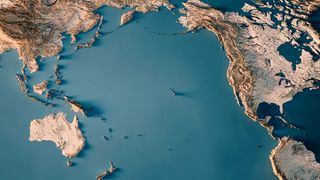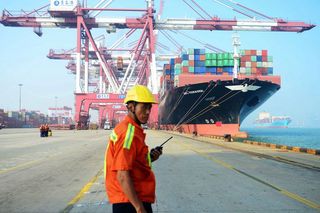After returning to the White House in January, President Donald Trump issued a flurry of executive orders, presidential memorandums, and policies. His lieutenants descended upon federal government departments and began an aggressive set of bureaucratic changes. To outside observers, and even Washington insiders, it is difficult to keep these actions straight and comprehend the potential significance of these efforts in isolation, let alone the implications of them collectively. The president’s most important strategic goal appears to be a combination of refashioning the US economy and re-engineering how global trade works.
While there is no guarantee that Trump and his administration will achieve the goal he has in mind, it is important to understand the president’s perspective, what he wants his administration to achieve, and how he intends to do it. If carried out successfully, these efforts could have enormous impacts on the global trade and economic system.
Individuals, businesses, and even countries, should weigh the potential risks to their own economic and business models. But also, and perhaps more importantly, they should consider the potential opportunities that a transformed US economy and global trading system might bring.
Contrary to nearly all his predecessors, Trump believes that US interests, and in particular American workers and companies, are disadvantaged by the liberal international economic system that emerged after the collapse of the Soviet Union.
To start, it is worth briefly describing Trump’s worldview. Contrary to nearly all his predecessors, Trump believes that US interests, and in particular American workers and companies, are disadvantaged by the liberal international economic system that emerged after the collapse of the Soviet Union. He believes that the United States embraced an ideology of ‘free trade’ as an unqualified virtue and unwisely disarmed itself by removing protections against the free flow of labour, capital, technology, and goods.
According to Trump, these decisions, which both Republican and Democratic politicians championed, led to the hollowing out of the US economy and industrial strength, while transferring jobs and wealth to the citizens of other nations. While in theory he may accept the arguments of David Ricardo’s comparative advantage, in practice he believes that this theoretical ideal rarely emerges as nations game the system to their own advantage. When these abuses became too blatant to ignore, he faults his predecessors as being too wedded to their ideological biases and too naïve to understand that appeals to legalistic norms shrink in the face of sovereign power. For Trump, the persistent and deepening trade deficit that the United States carries with the rest of the world (though not with Australia), is evidence of the failure of these theories. He is deeply critical of politicians and experts who put their faith in an ideal, which, in his opinion, does not exist in reality.
Closely linked to this suspicion about ‘free trade’ is his deep scepticism of multilateral organisations and international institutions which supposedly safeguard this liberal international economic system. Again, he may accept the theory of a rules-based order maintained by objective international organisations, but in practice he believes these entities cannot enforce the rules and that nations must protect the interests of their own citizens, instead of outsourcing it to others.
Lastly, Trump views the United States as well positioned to change the global trade and economic system. As the world’s largest and wealthiest consumer market with the deepest and richest capital markets, he believes the United States has enormous leverage in renegotiating the terms of trade with its partners individually.
The themes of this worldview are not new, and Trump campaigned on them in 2016, 2020, and 2024. In each subsequent campaign and during the Biden administration, Trump’s political opponents tacked closer to his views on these issues, giving him confidence that American voters share his concerns and have provided him a political mandate to change the global trade and economic system.
Renegotiating the terms of trade
Based on these themes, Trump looks to renegotiate much of the globalisation orthodoxy. Under that system, manufacturing and other industrial activities moved from the United States to other countries with either lower labour costs or to those who could negotiate trade agreements that both benefited their citizens and provided low barrier market access to the United States. Under this version of globalisation, the United States provided two public goods: security, which brought down the cost of commerce, and a market of last resort, that countries could sell into with few barriers which enable those countries to power their own economic development and prosperity.
Trump views this as an unsustainable arrangement, that places heavy burdens on the United States, which lets allies freeride on public goods, and allows rivals to build economic, industrial, military, and technological strength at the expense of the United States.
Rather than viewing the provision of security and market access to the United States as something Americans owe to the world, Trump seeks to share the cost of security with those that share values with the United States and to make access to the US market a privilege.
Rather than viewing the provision of security and market access to the United States as something Americans owe to the world, Trump seeks to share the cost of security with those that share values with the United States and to make access to the US market a privilege. To the degree that companies and countries want to assist in furthering US prosperity and to share in the profits, their investment and manufacturing in the United States will be welcome. The availability of abundant energy, a well-educated workforce, and most importantly, wealthy consumers who will consume large quantities of products and goods, is likely to be attractive to those who want to manufacture in the United States, for the United States. For those who can provide commodities and raw materials for this industrial and manufacturing renaissance that the United States cannot provide itself, those imports to the United States will be welcome at low or no tariff rates.
The responsibility for implementing these changes will fall primarily on five individuals, known colloquially as, the ‘trade team.’ Treasury Secretary Scott Bessent, Commerce Secretary Howard Lutnick, nominee for US Trade Representative Jamieson Greer, Director of the National Economic Council Kevin Hassett, and Senior Counselor for Trade and Manufacturing Peter Navarro.
An America First Trade Policy
The most far-reaching document that Trump signed on his first day in office was a presidential memorandum titled, America First Trade Policy. Addressed to his key cabinet officials, but available for the world to read, Trump’s trade policy lays out a roadmap for overhauling the way the United States conducts commerce with the world.
The policy directs the ‘trade team’ to undertake at least 21 investigations (with five specifically focused on the People’s Republic of China) into existing trade relationships, compliance with trade agreements, and any harms inflicted on the United States. These investigations, some of which include periods for public comment, unlock statutory authorities granted to the president or specific cabinet members. For example, if after an investigation by the Office of the US Trade Representative, it is determined that a foreign country is violating a trade agreement or placing unjustifiable burdens on US commerce, US Code 19, Section 2411, grants the trade representative broad authority to suspend the benefits of a trade agreement, impose duties, or restrict imports.
For those who want to understand the logic of what the United States is seeking to achieve during the second Trump administration, understanding Trump’s worldview, watching the actions of his ‘trade team,’ and following the roadmap of the America First Trade Policy will answer many questions.
The administration appears to be constructing a deliberate set of tools that it can rapidly employ to either achieve a specific policy goal, as demonstrated below, or to change the fundamental commercial calculus for businesses to manufacture products in the United States.
Under the section for economic security matters, the Trump administration has already implemented one portion of this policy. It directed the Secretary of Commerce and Secretary of Homeland Security to assess unlawful migration and fentanyl flows from Canada, Mexico, and the People’s Republic of China and recommend appropriate trade and national security measures. On 1 February, Trump signed three separate executive orders directing the imposition of tariffs on those three countries due to unlawful migration and fentanyl flows. Within 72 hours, the leaders of Canada and Mexico agreed to implement measures to address those two issues. Meanwhile China’s leader apparently refused to communicate with Trump and he ordered the imposition of an additional 10% tariff on all Chinese imports to the United States, as well as a suspension of duty-free de minimis treatment for Chinese imports under US$800.
While this trade policy offers a roadmap for where the Trump administration is going and preview of the tools it will use to get there, this process will inevitably unfold over months and years. For those who want to understand the logic of what the United States is seeking to achieve during the second Trump administration, understanding Trump’s worldview, watching the actions of his ‘trade team,’ and following the roadmap of the America First Trade Policy will answer many questions.









